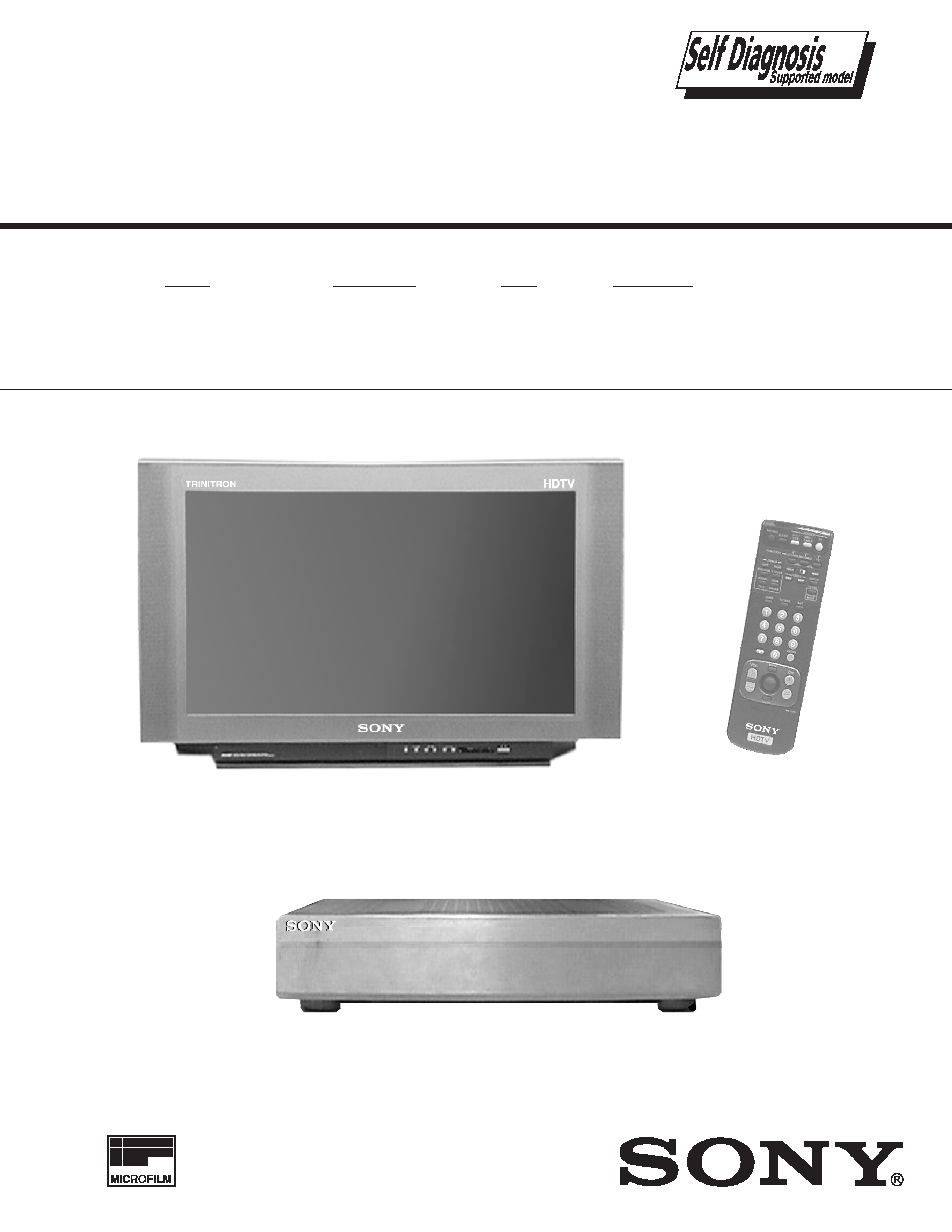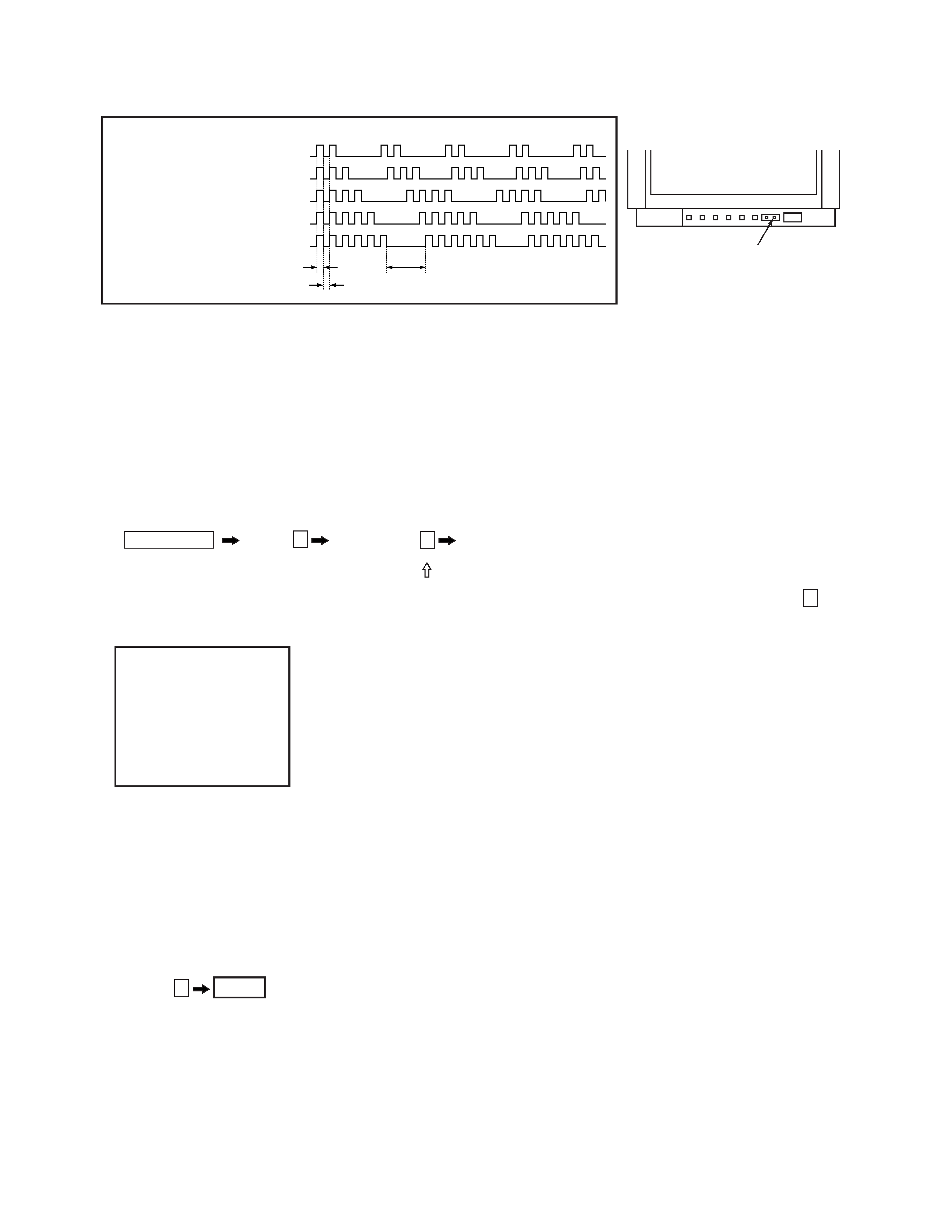
-- 1 --
KW-34HD1
TRINITRON® COLOR TV
KW-34HD1
RM-Y158
US
SCC-S17A-A
MODEL
COMMANDER
DEST.
CHASSIS NO.
TV Monitor
SERVICE MANUAL
CHASSIS
HA-1
RM-Y158
DTV Receiver

-- 2 --
KW-34HD1
SPECIFICATIONS
Television system:
American TV standard,
Actual screen size: 36-inch picture measured diagonally
NTSC, ATSC
Channel coverage:
DTV: 1-99, VHF: 2-13
Visible screen size: 34-inch picture measured diagonally
UHF: 14-69, CATV: 1-125
Picture Tube:
FD Trinitron® tube
Antenna: 75 ohm external terminal for VHF/UHF
Power Requirements:
120V, 60Hz
Power Consumption: TV Monitor
DTV Receiver
In use (max.)
300W
30W
In standby
3W
1W
Number of inputs/outputs:
Video
3
1 Vp-p, 75 ohms unbalanced, sync negative
S Video
3
Y: 1 Vp-p, 75 ohms unbalanced, sync negative
C: 0.286 Vp-p (Burst signal), 75 ohms
Audio Out
1
More than 408 mVrms at the maximum volume setting (variable)
More than 408 mVrms (fix)
Impedance (output): 2 kilohms
Control S (IN/OUT)
1
Y, PB, PR for DVD
1
Y: 1.0 Vp-p, 75 ohms, sync negative
PB: 0.7 Vp-p, 75 ohms
PR: 0.7 Vp-p, 75 ohms
fH: 15.734 kHZ, fV: 59.94 Hz
Y, PB, PR for HD
1
Y: 1.0 Vp-p, 75 ohms, Tri level sync
PB: 0.7 Vp-p, 75 ohms
PR: 0.7 Vp-p, 75 ohms
fH: 33.75 kHZ, fV: 60 Hz
Speaker output:
15Wx2
TV Monitor
DTV Receiver
Dimensions (WxHxD):
Dimensions (WxHxD):
(mm)
988 x 613 x 592 mm
(mm)
430 x 103 x 300.5 mm
(in)
373/4 x 241/8 x 23 3/8 in
(in)
17 x 43/4 x 117/8 in
Mass
(kg)
89 kg
Mass
(kg)
5 kg
(lbs)
196 lbs
(lbs)
11 lbs
Supplied Accessories:
Remote control (model RM-Y158) (w/2 size AA (R6) batteries)
Rubber Bumper (2), Coaxial cable, I/O cable
Optional Accessories:
Connecting Cables: RK-74A, RK-G69HG, VMC-10HG, VMC-720M, VMC-810/820S, YC-15V/30V
TV Stand 34HD1 (see specifications below)
U/V Mixer EAC-66
TV Stand
Dimensions (WxHxD)
(mm)
952 x 528 x 705 mm
Width is 1167mm with door open.
(in)
371/2 x 20 3/4 x 27 3/4 in
Width is 46" with door open.
Mass
(kg)
45 kg
(lbs)
99 lbs
Design and specifications are subject to change without notice.
(
)® SRS (SOUND RETRIEVAL SYSTEM)
The (
) SRS (SOUND RETRIEVAL SYSTEM) is manu-
factured by Sony Corporation under license from SRS
Labs, Inc. It is covered by U.S. Patent No. 4,748,669. Other
U.S. and foreign patents pending.
The word `SRS' and the SRS symbol (
) are registered
trademarks of SRS Labs, Inc.
BBE and BBE symbol are trademarks of BBE Sound,Inc.
and are licensed by BBE Sound, Inc. under USP
4638258.4482866,

-- 3 --
KW-34HD1
Warnings and Caution ..................................................... 4
Self-Diagnostic Function ................................................
4
Safety Check Out Instructions ........................................ 7
1. GENERAL
Setting up the TV, DTV Receiver and Stand.................8
Installing the DTV System............................................ 11
TV Controls and Connectors........................................ 15
Using the Remote Control............................................ 17
Troubleshooting.......................................................... 21
2. DISASSEMBLY
2-1.
Rear Cover and Speaker Removal.............................. 22
2-2.
Chassis Assembly Removal........................................ 22
2-3.
Service Position ......................................................... 22
2-4.
U Board Bracket Removal........................................... 22
2-5.
Picture Tube Removal ................................................ 23
2-6.
DTV Receiver Upper Case Removal.......................... 24
2-7.
DTV Receiver Front and Rear Panel Removal..........
24
2-8.
FE Board, MH Board, Power Supply Removal..........
24
3. SET-UP ADJUSTMENTS
3-1.
Beam Landing............................................................. 25
3-2.
V-Pin and V-Cen Adjustment...................................... 25
3-3.
Convergence Adjustment............................................ 26
3-4.
Focus Adjustment ...................................................... 27
3-5.
Screen (G2)................................................................ 27
3-6.
Picture Quality Adjustment......................................... 27
3-7.
White Balance and Sub Bright Adjustments.............. 31
3-8.
Raster Center Adjustment.......................................... 32
3-9.
Picture Distortion Adjustments...................................
33
3-10. 15KHz Mode Adjustment...........................................
33
3-11.
33KHz HD/31KHZ VGA/525P Mode Adjustment.......
35
3-12. Twin Picture Mode.....................................................
35
4. CIRCUIT ADJUSTMENTS.............................................. 32
TABLE OF CONTENTS
Section
Title
Page
Section
Title
Page
5. SAFETY RELATED ADJUSTMENTS.........................
50
6. DIAGRAMS
6-1.
Block Diagrams.......................................................... 51
6-2.
Circuit Boards Location.............................................. 64
6-3
Printed Wiring Boards and Schematic Diagrams ....... 64
·
A Board......................................................................
65
·
B Board......................................................................
77
·
D Board....................................................................... 85
·
G Board....................................................................... 93
·
M Board....................................................................... 101
·
V Board....................................................................... 109
·
C Board....................................................................... 125
·
U Board ..................................................................... 127
·
K Board......................................................................
128
·
H1 Board ......................................................................129
·
H2 Board ......................................................................130
·
W Board ...................................................................... 132
DTV Receiver Schematic Diagrams
·
Power Supply................................................................ 133
·
FE Board ......................................................................137
·
MH Board .................................................................... 141
6-4.Semiconductors...........................................................
157
7. EXPLODED VlEWS
7-1.
Chassis ...................................................................... 160
7-2 .
Picture Tube................................................................ 161
7-3.
TV Stand....................................................................
162
7-4.
DTV Receiver............................................................. 163
8. ELECTRICAL PARTS LIST
·
KV-34HD1 Monitor parts............................................... 165
·
Accessories/Packaging/Remote parts......................... 209
·
DTV Receiver parts...................................................... 210

-- 4 --
KW-34HD1
CAUTION!
SHORT CIRCUIT THE ANODE OF THE PICTURE TUBE AND
THE ANODE CAP TO THE METAL CHASSIS, CRT SHIELD,
OR CARBON PAINTED ON THE CRT, AFTER REMOVING
THE ANODE.
WARNING!!
AN ISOLATION TRANSFORMER SHOULD BE USED
DURING ANY SERVICE TO AVOID POSSIBLE SHOCK
HAZARD, BECAUSE OF LIVE CHASSIS.THE CHASSIS OF
THIS RECEIVER IS DIRECTLY CONNECTED TO THE AC
POWER LINE.
SAFETY-RELATED COMPONENT WARNING!!
COMPONENTS IDENTIFIED BY SHADING AND MARK
¡ ON THE SCHEMATIC DIAGRAMS, EXPLODED VIEWS
AND IN THE PARTS LIST ARE CRITICAL FOR SAFE
OPERATION. REPLACE THESE COMPONENTS WITH
SONY PARTS WHOSE PART NUMBERS APPEAR AS
SHOWN IN THIS MANUAL OR IN SUPPLEMENTS
PUBLISHED BY SONY. CIRCUIT ADJUSTMENTS THAT
ARE CRITICAL FOR SAFE OPERATION ARE IDENTIFIED
IN THIS MANUAL. FOLLOW THESE PROCEDURES
WHENEVER CRITICAL COMPONENTS ARE REPLACED
OR IMPROPER OPERATION IS SUSPECTED.
ATTENTION
APRES AVOIR DECONNECTE LE CAP DE L'ANODE, COURT-CIRCUITER
L'ANODE DU TUBE CATHODIQUE ET CELUI DE L'ANODE DU CAP AU
CHASSIS METALLIQUE DE L'APPAREIL, OU AU COUCHE DE CARBONE
PEINTE SUR LE TUBE CATHODIQUE OU AU BLINDAGE DU TUBE
CATHODIQUE.
ATTENTION!!
AFIN D'EVITER TOUT RESQUE D'ELECTROCUTION PROVENANT D'UN
CHÁSSIS SOUS TENSION, UN TRANSFORMATEUR D'ISOLEMENT DOIT
ETRE UTILISÉ LORS DE TOUT DÉPANNAGE. LE CHÁSSIS DE CE
RÉCEPTEUR EST DIRECTEMENT RACCORDÉ À L'ALIMENTATION
SECTEUR.
ATTENTION AUX COMPOSANTS RELATIFS A LA SECURITE!!
LES COMPOSANTS IDENTIFIES PAR UNE TRAME ET PAR UNE MARQUE
¡ SUR LES SCHEMAS DE PRINCIPE, LES VUES EXPLOSEES ET LES
LISTES DE PIECES SONT D'UNEIMPORTANCE CRITIQUE POUR LA
SECURITE DU FONCTIONNEMENT. NE LES REMPLACER QUE PAR DES
COMPOSANTS SONY DONT LE NUMERO DE PIECE EST INDIQUE DANS
LE PRESENT MANUEL OU DANS DES SUPPLEMENTS PUBLIES PAR
SONY. LES REGLAGES DE CIRCUIT DONT L'IMPORTANCE EST CRITIQUE
POUR LA SECURITE DU FONCTIONNEMENT SONT IDENTIFIES DANS
LE PRESENT MANUEL. SUIVRE CES PROCEDURES LORS DE CHAQUE
REMPLACEMENT DE COMPOSANTS CRITIQUES, OU LORSQU'UN
MAUVAIS FONTIONNEMENT SUSPECTE.
WARNINGS AND CAUTIONS
SELF-DIAGNOSTIC FUNCTION
The units in this manual contain a self-diagnostic function. If an error occurs, the STANDBY/TIMER lamp will automatically begin to
flash. The number of times the lamp flashes translates to a probable source of the problem. A definition of the STANDBY/TIMER lamp
flash indicators is listed in the instruction manual for the user's knowledge and reference. If an error symptom cannot be reproduced, the
remote commander can be used to review the failure occurrence data stored in memory to reveal past problems and how often these
problems occur.
1. DIAGNOSTIC TEST INDICATORS
When an error occurs, the STANDBY/TIMER lamp will flash a set number of times to indicate the possible cause of the problem. If there
is more than one error, the lamp will identify the first of the problem areas.
Results for all of the following diagnostic items are displayed on screen. No error has occured if the the screen displays a "0" .
Note 1: If a +B overcurrent is detected, stoppage of the vertical deflection is detected simultaneously.
The symptom that is diagnosed first by the microcontroller is displayed on the screen.
Note 2: Refer to Screen (G2) Adjustment in Section 3-4 of this manual.
Note 3: If standby lamp flashes 6 times, unplug unit and wait ten seconds before performing adjustment.
Diagnostic Item
No. of times
Self-diagnostic display/
Probable Cause
Detected Symptoms
Description
STANDBY/TIMER
Diagnostic result
Location
lamp flashes
* Power does not turn on
Does not light
* Power cord is not plugged in.
* Power does not come on.
* Fuse is burned out. (F5501)
* No power is suppled to the TV.
* AC power supply is faulty.
* +B overcurrent (OCP)
2 times
2:0 or 2:1
* H.OUT (Q4018) is shorted. (D board)
* Power does not come on.
(Note 1)
* +B REG (Q4022) is shorted. (D board)
* Load on power line is shorted.
* IC9001,9002, 9003 is shorted. (C board)
* +B overvoltage (OVP)
3 times
3:0 or 3:1
* IC5007 is faulty. (G Board)
* Has entered standby mode.
* Vertical deflection stopped
4 times
4:0 or 4:1
* +/-15V is not supplied. (G board)
* Has entered standby state after horizontal raster.
* IC 7003 is faulty. (D board)
* Vertical deflection pulse is stopped.
* Power line is shorted or power supply is stopped.
* White balance failure
5 times
5:0 or 5:1
* Video OUT (IC9001-9003) is faulty. (C board)
* No raster is generated.
(not balanced)
* MCP (IC3005) is faulty. (B board)
* CRT cathode current detection reference pulse
* G2 is improperly adjusted. (Note 2)
output is small.
* LOW B OCP/OVP
(overcurrent/overvoltage)
6 times
6:0 or 6:1
*+5 line is overloaded. (B,V Boards)
* No picture.
(Note 3)
*+5 line is shorted. (B,V Boards)
* IC5008 is faulty. (G Board)

-- 5 --
KW-34HD1
2. DISPLAY OF STANDBY/TIMER LIGHT FLASH COUNT
* One flash count is not used for self-diagnostic.
3. STOPPING THE STANDBY/TIMER FLASH
Turn off the power switch on the TV main unit or unplug the power cord from the outlet to stop the STANDBY/TIMER lamp from flashing.
4. SELF-DIAGNOSTIC SCREEN DISPLAY
For errors with symptoms such as "power sometimes shuts off" or "screen sometimes goes out" that cannot be confirmed, it is pos sible to bring up
past occurances of failure for confirmation on the screen:
[To Bring Up Screen Test]
In standby mode, press buttons on the remote commander sequentially in rapid succession as shown below:
Screen display
channel 5
Sound volume
Power ON
Note that this differs from entering the service mode (sound volume + ).
Self-Diagnostic screen display
5. HANDLING OF SELF-DIAGNOSTIC SCREEN DISPLAY
Since the diagnostic results displayed on the screen are not automatically cleared, always check the self-diagnostic screen during repairs. When
you have completed the repairs, clear the result display to "0".
Unless the result display is cleared to "0", the self-diagnostic function will not be able to detect subsequent faults after completion of the repairs.
[Clearing the result display]
To clear the result display to "0", press buttons on the remote commander sequentially as shown below when the diagnostic screen is being
displayed.
Channel 8
ENTER
[Quitting Self-diagnostic screen]
To quit the entire self-diagnostic screen, turn off the power switch on the remote commander or the main unit.
STANDBY/SLEEP lamp
< Diagnostic items >
< Flash count >
· +B overcurrent
2 times
· +B overvoltage
3 times
· Vertical deflection
4 times
stopped
· White balance failure
5 times
· Low B OCP/OVP
6 times
Lamp ON 0.3 sec.
Lamp OFF 0.3 sec.
Lamp OFF
3 sec.
SELF DIAGNOSTIC
2: +B OCP
0 <-------------Numeral "0" means that no fault has been detected.
3: +B OVP
0
4: V STOP
0
5: AKB
1 <-------------Numeral "1" means a fault has been detected one time only.
6: LOWB
0
101: WDT
0
